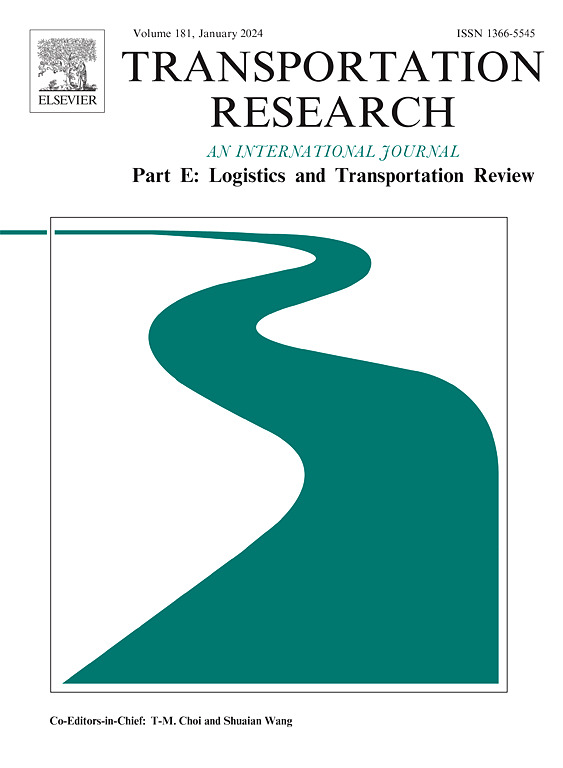用于减少供应链变化的生产和分配调度数学
IF 8.3
1区 工程技术
Q1 ECONOMICS
Transportation Research Part E-Logistics and Transportation Review
Pub Date : 2025-02-01
DOI:10.1016/j.tre.2024.103905
引用次数: 0
摘要
在供应链网络中,满足商店层面的需求与在制造商(或工厂)层面的顺利生产通常是相互冲突的目标。例如,如果商店可以准确地订购他们需要的东西和他们需要的时间,那么生产变化将会很大。另一方面,每天生产相同数量的产品不利于适应需求的变化,可能导致库存短缺或过剩。本研究是与一家大型快速消费品公司合作进行的,提出了一种用于以综合方式管理供应链的词典编纂模型。七个目标函数被认为代表了供应链(从商店到工厂)和不同优先级的各种利益相关者的目标。设计了一种局部搜索和精确方法相结合的数学方法,用于调度供应链上的生产订单和发货,以优化整体成本结构。在局部搜索启发式中采用的邻域结构能够针对单个目标函数(例如,短缺,生产可变性,库存水平)和单个解决方案特征(例如,生产,运输)执行专门的修改,而不会降低更高级别目标的价值。由于计算时间有限,提出了一种时间管理方法。实验在公司生成的120个实例上进行,以捕捉它所面临的真实情况。使用预测需求的滚动窗口模拟,我们表明我们的方法明显优于商业求解器和实践中使用的几种常用策略。在运行时和解决方案质量方面,所建议的方法的好处是突出的。本文章由计算机程序翻译,如有差异,请以英文原文为准。
A production and distribution scheduling matheuristic for reducing supply chain variations
In a supply chain network, satisfying the demand at the shop level while having a smooth production at the manufacturer (or plant) level are usually conflicting objectives. For instance, the production variations will be high if the shops can order exactly what they need and when they need it. On the other hand, producing the same amount each day prevents to adapt to the variations of the demand and may generate shortages or excess inventory. This study, performed in collaboration with a major fast-moving consumer goods company, proposes a lexicographic model for managing the supply chain in an integrated manner. Seven objective functions are considered to represent the goals of various stakeholders along the supply chain (from the shop to the plant) and different priority levels. A matheuristic combining both local-search procedures and exact methods is designed for scheduling the production orders and the shipments along the supply chain to optimize the overall cost structure. The proposed neighborhood structures employed in the local-search heuristics are able to perform dedicated modifications with respect to a single objective function (e.g., shortage, production variability, inventory level) and a single solution characteristic (e.g., production, shipment) without degrading the value of higher-level objectives. As computation time is limited, a time management approach for this method is proposed. Experiments are performed on 120 instances generated with the company to capture the real situations it faces. Using a rolling-window simulation with forecasted demands, we show that our method clearly outperforms a commercial solver and several common policies used in practice. The benefit of the proposed approach is highlighted both in terms of runtime and solution quality.
求助全文
通过发布文献求助,成功后即可免费获取论文全文。
去求助
来源期刊
CiteScore
16.20
自引率
16.00%
发文量
285
审稿时长
62 days
期刊介绍:
Transportation Research Part E: Logistics and Transportation Review is a reputable journal that publishes high-quality articles covering a wide range of topics in the field of logistics and transportation research. The journal welcomes submissions on various subjects, including transport economics, transport infrastructure and investment appraisal, evaluation of public policies related to transportation, empirical and analytical studies of logistics management practices and performance, logistics and operations models, and logistics and supply chain management.
Part E aims to provide informative and well-researched articles that contribute to the understanding and advancement of the field. The content of the journal is complementary to other prestigious journals in transportation research, such as Transportation Research Part A: Policy and Practice, Part B: Methodological, Part C: Emerging Technologies, Part D: Transport and Environment, and Part F: Traffic Psychology and Behaviour. Together, these journals form a comprehensive and cohesive reference for current research in transportation science.

 求助内容:
求助内容: 应助结果提醒方式:
应助结果提醒方式:


